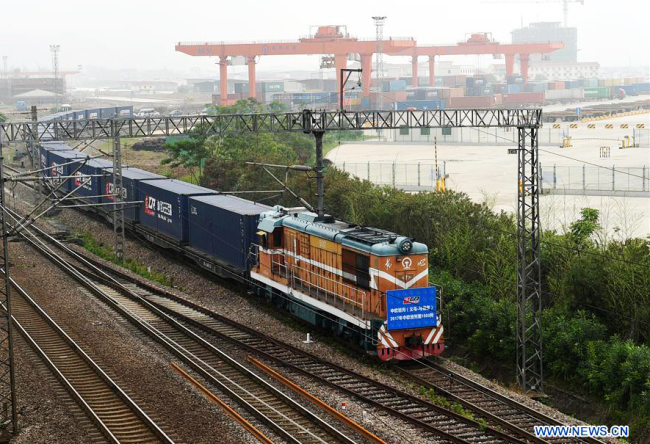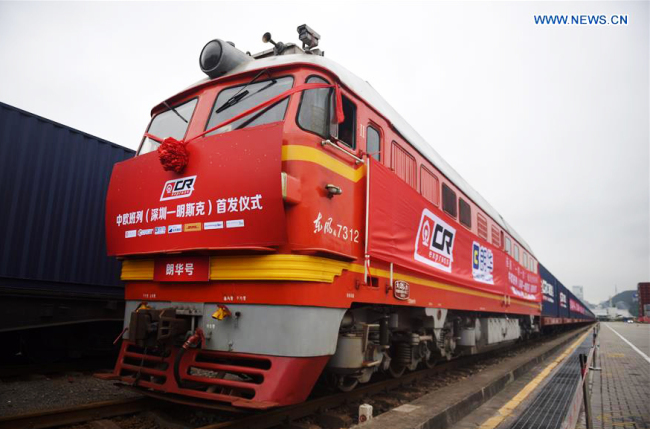


Photo taken on November 10, 2017 shows the cargo train during a launching ceremony of the railway route in Kouvola, Finland. With more than 40 containers on it, the cargo train bound for Chinese inland city of Xi'an departed Kouvola, southeastern Finland, on November 10, 2017. [Photo: Xinhua]
The "China-CEE 16+1" concept was adopted in 2012 by China and 16 Central and Eastern European or CEE countries. Focused primarily on economy and trade, one of the keys to expanding the links are the series of express trains which run between China and Europe.
Since the launch of the first China-Europe freight rail line linking Chongqing with Duisburg, Germany in March 2011, freight volume between China and European countries has risen in each of the last six years.
Thanks to the series of new routes launched by China-Europe Railway Express, more and more Chinese companies are now choosing to use rail to import goods from Europe.

The 1,000th freight train linking China and Europe in 2017 departs from the Yiwu West Railway Station in Yiwu, Zhejiang Province, May 13, 2017. [Photo: Xinhua]
Kevin Wang is the European market sales director for the Xiamen Golden Dragon Bus Company. He said the company started to use the China-Europe freight trains in 2014, and often uses the railways to import engines and other components from Western Europe such as Italy. They are also planning to start shipping their buses to Eastern Europe via the rail lines.
Compared with air and sea freight, the trains have their own advantages. Kevin Wang said previously the company mainly shipped products by sea. Since 2014, however, the bus manufacturer has benefited from the trains between China and Europe, as the rails are cheaper than air freight while being faster and more punctual than transportation by sea.
The China-Europe freight train is a significant part of the Belt and Road Initiative proposed by Chinese President Xi Jinping in 2013.

Photo taken on May 22, 2017 shows freight train X8428, with a total travelling length of 9,900 kilometers and bound for Minsk of Belarus, departs from Shenzhen's Yantian Port, marking the opening of a new China-Europe freight train route starting from Shenzhen. [Photo: Xinhua]
Kevin Wang said that the Belt and Road Initiative has opened up new opportunities not only for Chinese companies, buy also European ones.
He takes his company as an example, saying that "producing buses usually requires very high-cost investment. In Eastern Europe, people were used to buying second-hand buses from Western Europe; but now, with the support of the special initiative, they can pay the same amount of money and get brand-new buses. It's a good move to help Chinese enterprises go abroad."

Photo taken on May 22, 2017 shows freight train X8428, with a total travelling length of 9,900 kilometers and bound for Minsk of Belarus, departs from Shenzhen's Yantian Port, marking the opening of a new China-Europe freight train route starting from Shenzhen. [Photo: Xinhua]
Apart from bringing opportunities for domestic companies, the China-Europe freight trains also promote economic exchanges along the Silk Road.
Wang Yiwei, Director of Center for EU Studies of Renmin University of China, says rail routes have boosted connectivity between China and Europe.
"China-Europe Railway Express has been boosting the logistics and transportation, and a new type of the business between China and Europe. Most importantly, it's about the new value chain distribution, because it's located in the heartland of China and European cities. It helps China to cooperate with European local governments."
In addition, he suggests that China-Europe freight trains can narrow the gap between the 16 European nations, as well as the rail links should also help with the integration of Europe itself.
ny of the railway route in Kouvola, Finland. With more than 40 containers on it, the cargo train bound for Chinese inland city of Xi'an departed Kouvola, southeastern Finland, on November 10, 2017. [Photo: Xinhua]
China now has 57 China-Europe freight train routes, with trains from 35 Chinese cities traveling to 12 European countries.

 Award-winning photos show poverty reduction achievements in NE China's Jilin province
Award-winning photos show poverty reduction achievements in NE China's Jilin province People dance to greet advent of New Year in Ameiqituo Town, Guizhou
People dance to greet advent of New Year in Ameiqituo Town, Guizhou Fire brigade in Shanghai holds group wedding
Fire brigade in Shanghai holds group wedding Tourists enjoy ice sculptures in Datan Town, north China
Tourists enjoy ice sculptures in Datan Town, north China Sunset scenery of Dayan Pagoda in Xi'an
Sunset scenery of Dayan Pagoda in Xi'an Tourists have fun at scenic spot in Nanlong Town, NW China
Tourists have fun at scenic spot in Nanlong Town, NW China Harbin attracts tourists by making best use of ice in winter
Harbin attracts tourists by making best use of ice in winter In pics: FIS Alpine Ski Women's World Cup Slalom
In pics: FIS Alpine Ski Women's World Cup Slalom Black-necked cranes rest at reservoir in Lhunzhub County, Lhasa
Black-necked cranes rest at reservoir in Lhunzhub County, Lhasa China's FAST telescope will be available to foreign scientists in April
China's FAST telescope will be available to foreign scientists in April